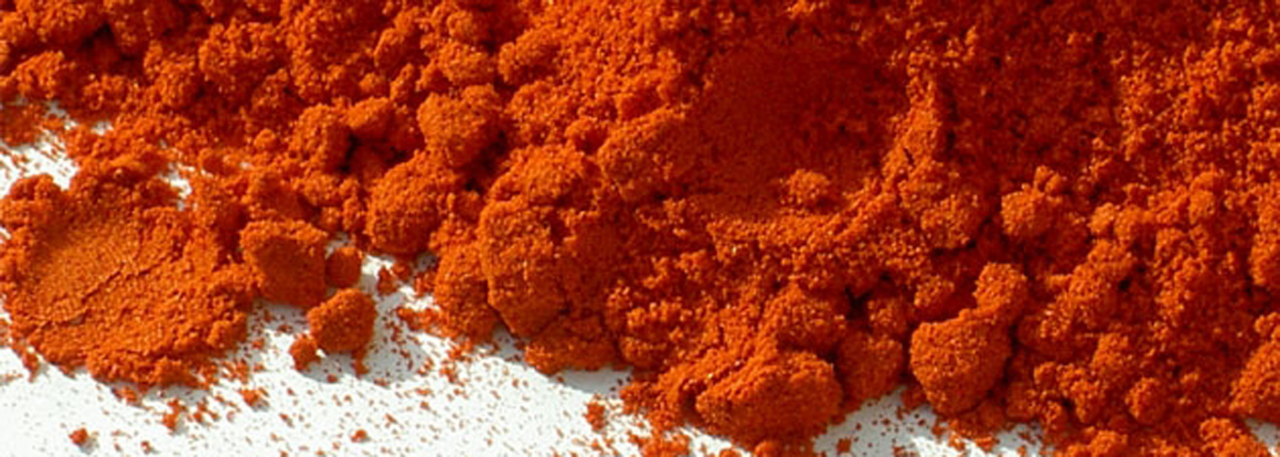.png.transform/rendition-xs/image_image%20(1).png)
Pimentón de Murcia PDO
The product resulting from the grinding of completely red peppers, Capsicum Annuum L., Bola variety, from the designated production area.
Tasting notes
The aroma is characteristically strong and penetrating, and the taste is sweet, oily and flavorsome. Both color and aroma are very stable.
Other notes
Physical-chemical parameters :
- Grain size: the peppers are ground using a size 16 mesh on the ASTM scale (equivalent to 1.19 mm mesh openings)
- Color at time of grinding (minimum Asta units): 120 for Extra category and 90 for category 1
- Maximum moisture content: 14% for both categories, Extra and 1
- Ethereal extract over dry matter: maximum 20% for Extra category and 23% for category 1
Ash over maximum dry matter:
- Total: 7.5 for Extra category and 8 for category 1
- Insoluble: 0.7 for Extra category and 1 for category 1
- Gross fiber over dry matter: 27% for Extra category and 28% for category 1.
- Maximum capsaicin content: 0.003 for both categories, Extra and 1.
Production / Processing method
The pepper or capsicum plant is a fairly well-developing one. When the main stem reaches 12-14 cm, it has already a developed branch with fruits. The trunk usually divides at 25 cm, having three main branches. The angle formed by every two of these branches is about 40º. The leaves are fairly large.
From the point of view of pimentón production, the dried fruit has three parts – a pericarp, seeds and a peduncle. In the dried fruits, these are present as follows: a minimum of 50% pericarp, a maximum of 40% seeds and a maximum of 8% peduncle. The ratio between the fruit’s fresh and dried weights must be five to one.
Peppers grow in a warm climate and for optimum development and yield, daytime temperatures should be between 20 and 25ºC / 68-77ºF and night-time temperatures between 16 and 18ºC / 60-64ºF. Above 32ºC / 90ºF, flower abortion may result, especially under dry conditions. With high relative humidity, plants tolerate temperatures of over 40ºC/104ºF. This crop requires 50-70% relative humidity, especially during flowering and flower set. It tolerates higher relative humidity during the initial phases of development than later on.
The pepper also requires plenty of light throughout the vegetative cycle, especially during flowering, fruit set and ripening. Without sufficient light, the plant becomes spindly, making the internodes and stems elongated and weak so that they can no longer hold the weight of the fruits.
Peppers are propagated by seed, and sowing takes place from mid-December to early January. To counter the natural conditions at this time of the year which are not suitable for germination or development of the young plants, it is necessary to use special seed-beds. These are rectangular frames placed in the ground – with a width of approximately 1.5 meter and the length depending on the leveled ground – that are covered with plastic, to act as hotbeds. Farmers prepare these beds using their own seeds from the sundried fruits picked at the start of the previous harvest, after first selecting the highest-yielding plants. Once they have obtained certified seeds, it is obligatory to use them.
Once the seeds have germinated and the plants are sprouting, the plastic is gradually broken to encourage air circulation and prevent excessive heat inside the seed-bed. Then the plastic is completely removed about ten to 15 days before the plantlets are to be transferred to the growing area. This enables them to gradually become acclimatized to the field environment while their roots develop.
Planting may be done in a number of ways, the most usual being to use plastic mulch which eliminates the need for hoeing, earthing up, etc. It also allows for high plant density and uses less water than the traditional furrow system. After preparing the ground, the black plastic is laid by tractor and transplanting takes place immediately after. In traditional cultivation, after leveling the ground, furrows are made then the plants are transplanted in them.
Finally, if localized irrigation is used, first a layer of fertilizer is buried then the drip pipes are placed, the ground is watered and the plants are transplanted. In all cases, it is important that irrigation should not create puddles which might damage the young roots.
Transplanting in the field is usually done by hand with naked roots as from early April, by which time there is usually no frost. The ground is first broken down, leveled and loosened, then mineral fertilizers and manure are added along with plenty of water to ensure that the plantlets root well. Pests and plant diseases are mostly treated using integrated control and organic methods.
The Bola variety is a small, sub-spherical sweet pepper with a green peduncle. The pericarp is semi-fleshy, and the inside of the fruit is divided into three even-sized compartments separated by slightly fleshy walls and containing plenty of seeds that practically fill the fruit. The color of the pimentón comes from the carotene pigments in the pepper. The main colorants that are typical of this variety and distinguish it from others are capsanthin, present in a percentage of around 50%, and capsorrubin, at about 12%. The fruits are picked by hand as they reach maximum ripeness, when they have attained maximum color intensity and therefore have a greater content of natural pigments and minimum water content. The peppers must be healthy, clean, dry and free from pests or disease.
Drying can be done naturally or using hot air. In the former case, the peppers are placed on drying racks and exposed to the sun for several days. The pericarp is then scratched to encourage dehydration. With this method, the peduncle may be removed. In the latter case, the peppers are first washed in drinking water to remove any leaves, twigs or dirt then dried on trays using horizontal or, more commonly, vertical hot air currents. The product must not exceed the critical temperature of 149-167ºF, and the exhaust air may have a temperature of about 104ºF. Drying takes place for eight to ten hours. The final moisture content must be no more than 14%. Until the fruits are crushed, they must be kept in a dry place to ensure their moisture content does not rise.
The dried fruits are first crushed using a hammer mill, then ground to produce a fine, bright red powder. During this process, the temperature may not rise above 113ºF. Milling brings out the oily elements which are responsible for the product’s high quality as they increase its coloring capacity and ensure that it can be fully incorporated into foods, especially charcuterie products.
The pimentón is packed in new, clean containers made of materials authorized by the Regulatory Council, which must be stable, and must neither transmit flavors or smells nor alter the product in any way.
The end product must contain no seeds from other varieties nor placentas, calyces or stems in a proportion higher than that in the fruit itself, and must be free from artificial colorants or other substances altering the parameters that define this species.
Geography / Relief and climate
Over the years these peppers have become more rounded in shape and the flavor is no longer pungent but sweet. This is the result of the sub-tropical Mediterranean climate, the scarce rainfall and high temperatures, saline, dry soils and the local growing techniques.
The production area is located in the south-east of the Iberian peninsula in the Region of Murcia, which covers an area of 11,320 km2, one quarter of which lies low at an altitude of under 200 m, 45% is at medium altitudes between 200 and 600 meters and 32% is located at 600 to 2,000 m. The relief is complex, with high mountains in the north-west of the region.
From the geological point of view, most of the area is located in the Béticas mountains which are mostly surrounded by depressions with neogenic-quaternary materials. The mountains stretch in a south-west to north-east direction. Many of the materials are postorogenic, with deposits of marl, clay, evaporitic rocks and conglomerates. The quaternary deposits are present in large plains and river basins, sometimes forming spectacular glacis. In general, these are the best growing areas for both dry and irrigated farming. The soils in Campo de Cartagena and the Guadalentin Valley where peppers are grown can be classified as saline. Where the salt content is low, the salinity is structural, that is, it is a characteristic of the soil, whereas in other cases it may be the result of chlorides brought in with irrigation water.
The climate can generally be defined as subtropical Mediterranean with maritime characteristics near the coast and high levels of average potential evapotranspiration which, in the months of July and August, may reach as much as 180. This, together with the very low average rainfall of less than 300 mm and the high average temperatures, characterizes the local ecology and affects the soil, especially with regard to soluble salts because constant irrigation is required for cultivation. 97% of the region lies within the Segura river basin. In addition to the main river, which crosses the region from the Cenajo reservoir to Beniel, there are a number of tributaries including, on the right bank, the Moratalla, Argos, Quipar, Mula and Guadalentín rivers, the latter covering a large proportion of the basin. There are also many river beds which may carry brackish water, especially those of the Moro, Judío, Tinajón, Salada, Agua amarga rivers and others.
The water for irrigation in the production area mostly comes from the Tagus-Segura river transfer and from the existing aquifers which have a high saline content and are currently overused although much of the irrigated farming area has insufficient water supply.
The economy of the Region of Murcia is based on agriculture and agrifood and depends to a great extent on the availability of water for farming. In 1996, the cultivated surface area was just over 50% of the total. The remainder was mostly scrubland and pastures at about 30% followed by wooded areas, especially pine forests at about 15%.
The irrigated area stands at about 200,000 ha (494,000 acres) although this depends on water availability. About half of this grows vegetables, followed by drupes such as peaches and apricots, then citrus fruits such as oranges and lemons and lastly, to a lesser extent, olives, grapes, forced crops, etc.
Dry farming occupies over 400,000 ha (988,400 acres). The majority grows low-yielding cereal crops, especially barley, but it is largely associated with cattle farming. Finally, other crops include almonds and grapes and, to a lesser extent, olives, carobs, etc.
Regulatory Council
Consejo Regulador de la DOP Pimentón de Murcia
Av. Santa Eulalia, 7
30850 Totana (Murcia)
Tel: (+34) 968 424 016
pimentonmurcia@gmail.com
info@pimentondemurcia.es
www.pimentondemurcia.es
Sources:
- Spanish Ministry of Agriculture
Over the years these peppers have become more rounded in shape and the flavor is no longer pungent but sweet.


- Pimentón de Murcia 1
- Pimentón de Murcia 2

Totana (Murcia)
